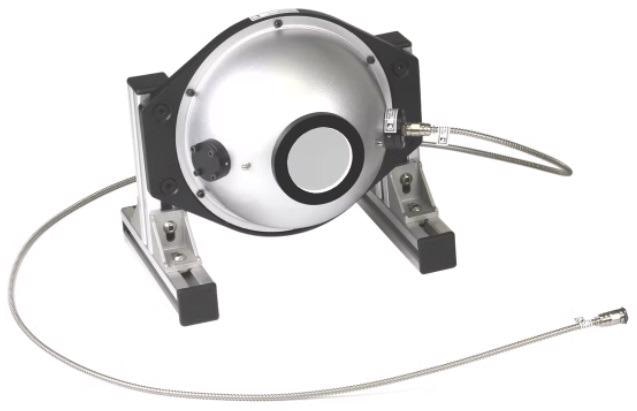An integrating sphere is a hollow spherical cavity that features a highly reflective white coating. These devices can be used to measure the total luminous flux from lamps or the power of laser light, for example.
Integrating spheres are similar to cosine correctors or lenses-only optics. These devices require a connected and calibrated detector to work, for example, a spectroradiometer.

Image Credit: Admesy
Using an Integrating Sphere
When acquiring a measurement, the sample - in this instance, a light source - is placed in front of the sphere opening (2 π) to perform an irradiance measurement. It is also possible to set the sample inside the integrating sphere (4π) to capture the entire radiant flux.
In both of these measurement setups, light rays are bounced off the reflective coating several times to ensure homogeneous light distribution throughout the whole integrating sphere.
The Role of Baffles
Baffles are an important component because the light entering an integrating sphere should not be permitted to directly strike the detector or the point on the interior of the sphere from which the detector gathers direct reflectance.
Baffles are used in most integrating sphere designs, but these can cause specific inaccuracies as they prevent the integrating sphere from achieving a perfectly spherical interior cavity. It is, therefore, advisable to limit the number of baffles and ports installed in an integrating sphere.
Reflective Coatings
Two factors should be considered when choosing a reflective finish for an integrating sphere: reflectance and durability. All components (including baffles) must be coated with diffuse and highly reflective material to ensure that every wavelength of light entering the sphere is appropriately reflected.
A more resilient, washable coating should be selected in instances where the sphere is utilized in dirty or dusty surroundings or where there is an abundance of light. Dirt and dust absorb light and affect the reflectance of specific wavelengths, so these should be avoided as much as possible.
Uses of Integrating Spheres
One of the most common applications of an integrating sphere is the measurement of total luminous flux from lightbulbs and lamps. For these applications, integrating sphere diameters can be as little as two centimeters or as large as two meters.
An integrating sphere’s optimum size is determined by the size of the light source, though larger spheres tend to offer improved uniformity due to their larger surface.
When employed in conjunction with a spectrometer, an integrating sphere is able to provide data on essential spectral parameters such as dominant wavelength, chromaticity and spectral power distribution.
An integrating sphere can be used to capture and incorporate laser beams and even divergent sources like laser diodes. It can be constructed to accommodate a wide range of incident angles over a large location with adverse effects on the detector signal.
These devices also offer an ideal means of measuring irradiance in a similar manner to a cosine corrector. When correctly designed, the output aperture of an integrating sphere can generate a near-perfect diffuse and Lambertian light source, distinct from the viewing angle.
Under these circumstances, the light source will be positioned outside of the integrating sphere (2-pi measurement).
Integrating spheres see frequent use in reflection and transmission measurements, particularly where there is a need to acquire accurate and detailed spectral information about materials, for example, the glass used in greenhouses and other horticultural applications.

This information has been sourced, reviewed and adapted from materials provided by Admesy.
For more information on this source, please visit Admesy.